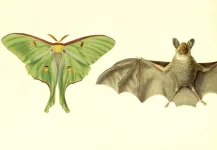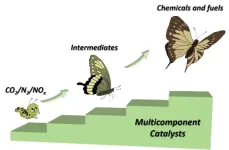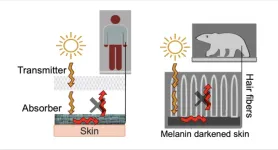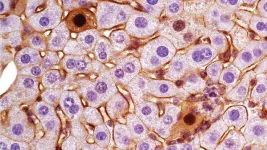(Press-News.org) In a pair of complementary studies, researchers took a close look at Luna moth (Actias luna) tails through the eyes of birds and female moths to test the tails’ role in predation and sexual selection. Scientists have known for about a decade that Luna moths — and other related silkmoths — use their long, trailing tails to misdirect bat attacks.
“They have projections off the back of the hindwing that end in twisted, cupped paddles,” said Juliette Rubin, a doctoral student at the Florida Museum of Natural History and lead author of both studies. “From experimental work with bats and moths in a flight room, we’ve found that these structures seem to reflect bat sonar in such a way that bats often aim their attacks at the tails instead of the main body.”
Traits that evolve for one specific function can often be co-opted by natural selection for another, and Rubin wondered whether the twisted tails of Luna moths might come with any additional benefits or hidden costs.
Male Luna moths doff their tails, retain their charm
Silkmoths have independently evolved tails on multiple occasions across three continents, and the appendages can vary significantly in length. Hind wings in some species can extend to more than twice the size of the moth’s wingspan, and the longer the tail, the more likely a moth will successfully thwart a prowling bat.
But far from being drab, utilitarian decoys meant only for sonar-sensing bats, silkmoth tails are often visually stunning, like decorative streamers trailing behind a kite. Across the animal and plant kingdoms, many of the most colorful and alluring structures are used to attract mates or pollinators, and scientists suspected the same might be true of silkmoth tails.
This type of dual function for a single trait isn’t without precedent. The vivid colors of strawberry poison dart frogs (Oophaga pumilio) both deter predators and help males attract mates; male deer and other ungulates use their antlers to fight off rivals and signal their vigor to females; and moths that use clicks or chirruping sounds to disrupt bat echolocation can compose duets using the same sounds during courtship.
Luna moths have neither mouths to produce sound nor ears to hear it, but they do have sensitive eyes and powerful scent-detecting antennae. When female Luna moths are ready to mate, they perch in one place and emit a pheromone, a single molecule of which is enough to trigger a male antenna. The males of closely related Indian moon moths (Actias selene) can find females from more than six miles away by following the pheromone plume to its source.
“We don’t know how many males are traveling to a female each night,” Rubin said. “It’s entirely possible she’s able to call in multiple suitors and potentially have her pick.”
Rubin put this idea to the test, setting up mating experiments in which a female Luna moth was enclosed in a flight box with two males: one with normal hind wings, and one with its tails removed.
Initially, the data seemed to suggest that females preferred males whose wings remained intact, but additional controlled experiments demonstrated that this was more likely an incidental effect of the tail removal. During trials in which both males had their wings clipped, and one had the tails glued back on, there was no difference in their mating success.
Do tails make Luna moths invisible to bats but conspicuous to birds?
Having demonstrated tail wings likely weren’t conferring any additional benefits beyond survival, Rubin wanted to see whether they had any obvious drawbacks. Their long tails effectively throw off pursuing bats by creating a decoy target, but bats aren’t the only adversaries Luna moths have to avoid. Their electric green tails with bright, pink parfait borders might make Luna moths noticeable to birds and other visually oriented predators that hunt during the day.
Other organisms contend with similar tradeoffs. The bioluminescent displays of fireflies make it easier for males to locate potential mates, but it also makes them stand out to nocturnal frogs and geckoes.
Luna moths live incredibly short lives, during which they can afford to lose a tail or two. Once they emerge from their cocoons, the moths have about a week to find a mate and reproduce before dying. “This creates a very intense period of adulthood, where surviving the night is of the utmost importance,” Rubin said.
Luna moths are mostly inactive during the day, reducing their chances of being nabbed midair. If they don’t do a good enough job concealing themselves, however, they run the risk of not surviving to nightfall.
Rubin wanted to know if their visually elaborate tails put Luna moths at a disadvantage in this high-stakes game of hide-and-seek. To find out, she and her colleagues wrapped mealworms in pastry dough in the shape and size of Luna moth bodies, to which they attached real wings, half of which had tails. They partially hid these moth replicas among branches and leaves in an aviary, then introduced a succession of Carolina wrens (Thryothorus ludovicianus), recording how many of the snacks the birds located and ate.
The results conclusively indicate that the tails had no effect on the birds’ ability to locate the fake moths. This might seem odd to us, Rubin said, because we’re such visually oriented animals. But there’s evidence that suggests birds might rely on search images when trying to distinguish food items from patterns in the background.
Humans do this too. When trying to complete a Where’s Waldo puzzle, people often look for the characteristic red, horizontal lines of Waldo’s shirt while scanning across the page. It’s possible that Luna moth tails don’t match the typical moth and butterfly mold that birds expect to see while foraging, the equivalent of Waldo wearing a solid red shirt rather than his signature stripes.
While not indicative of all silkmoths, the studies suggest that these stunning and complex structures evolved for a single function in Luna moths.
“When we see these really obvious physical features in animals, we’re often drawn into stories we’ve heard about them,” Rubin said. “One is that conspicuous traits are for attracting mates or competing with rivals, and another is that these very showy traits must come with a cost. Both of these studies show it’s really important to test those assumptions. A trait that’s obvious to us, as visual creatures, might not stand out to the predators that hunt them, and the traits that we think are dynamic and alluring might not seem that way to a potential mate.”
The studies were published in the journals Biology Letters and Behavioral Ecology. Akito Kawahara of the Florida Museum of Natural History, and Nich Martin and Kathryn Sieving of the University of Florida are also co-authors.
END
What is it good for? Absolutely one thing. Luna moths use their tails solely for bat evasion
2023-04-10
ELSE PRESS RELEASES FROM THIS DATE:
Breaking inert bonds: Multicomponent catalysts pave the way for green chemistry and green carbon science
2023-04-10
The chemical industry has played a significant role in the development of society, but its impact on the environment has become a growing concern. Green chemistry and chemical engineering have opened up possibilities for sustainability through the transformation of renewable feedstocks into environmentally friendly chemicals. However, the inert bonds in molecules such as CO2 and N2 present challenges to their activation and conversion.
Electrochemical conversion provides a promising carbon-neutral route to upgrading green chemical sources with inert bonds to chemicals and fuels under ambient conditions. Multicomponent electrocatalysts have advantages over monocomponent catalysts, ...
New textile unravels warmth-trapping secrets of polar bear fur
2023-04-10
AMHERST, Mass. – Three engineers at the University of Massachusetts Amherst have invented a fabric that concludes the 80-year quest to make a synthetic textile modeled on Polar bear fur. The results, published recently in the journal ACS Applied Materials and Interfaces, are already being developed into commercially available products.
Polar bears live in some of the harshest conditions on earth, shrugging off Arctic temperatures as low as -50 Fahrenheit. While the bears have many adaptations that allow them to thrive when the temperature plummets, since the 1940s scientists have focused on one in particular: their fur. How, the scientific community ...
Navigating the cosmos with Georgia State’s CHARA Array
2023-04-10
ATLANTA—Plans are underway to add a seventh movable telescope to Georgia State University’s Center for High Angular Resolution Astronomy— known as the CHARA Array—that would increase the resolution, or the ability to see small objects, by a factor of three.
Located at Mount Wilson Observatory in Southern California and operated by Georgia State, the new telescope will be connected using fiber optics to transport the starlight, a technique that will serve as a pathfinder ...
BU doc honored by the Association of University Radiologists
2023-04-10
(Boston)— Priscilla J. Slanetz, MD, MPH, professor of radiology at Boston University Chobanian & Avedisian School of Medicine, was awarded the 2023 Association of Program Directors in Radiology (APDR) Achievement Award at the Association of University Radiologists’ annual meeting. The honor is given for outstanding service to APDR or to someone who has made significant contributions to the advancement of education in radiology.
Slanetz is a practicing breast radiologist at Boston Medical Center specializing in all aspects of breast imaging including screening, diagnostic evaluation and image-guided intervention, providing breast care to Boston’s most vulnerable ...
BU researcher awarded $1.5 million NIH grant
2023-04-10
Boston—Esther Bullitt, PhD, associate professor of pharmacology, physiology & biophysics at Boston University Chobanian & Avedisian School of Medicine, was awarded $1.5 million from the National Institutes of Health that will go toward the purchase of a cryogenic electron microscope. Additional funds have been pledged by University President Robert A. Brown and Professor and Chair of Pharmacology, Physiology & Biophysics Venetia Zachariou, PhD.
The FEI ThermoFisher Glacios-2 cryo-EM is capable of determining structures at near-atomic resolution. Researchers will use this new instrumentation to study cellular function and dysfunction, and to guide ...
New UK data system will help predict and prevent opioid overdoses in Kentucky
2023-04-10
LEXINGTON, Ky. (April 10, 2023) — University of Kentucky researchers are creating an innovative statewide surveillance system to inform prevention and response efforts aimed at reducing the burden of opioid use disorder in Kentucky.
The Rapid Actionable Data for Opioid Response in Kentucky (RADOR-KY) will use data from federal, state, and local sources to guide evidence-based practices aimed at preventing opioid overdoses in the Commonwealth. Phase one of the project is supported by a three-year $3.1 million grant from the National Institute on Drug Abuse (NIDA).
Driven by the COVID-19 pandemic and illegally manufactured fentanyl, drug overdose ...
AACR announces recipients of the 2023 AACR June L. Biedler Prize for Cancer Journalism
2023-04-10
PHILADELPHIA – The American Association for Cancer Research (AACR) is pleased to announce the recipients of the 2023 AACR June L. Biedler Prize for Cancer Journalism in the following categories:
Auditory Journalism
“‘No Mercy’ Chapter 5: With Rural Hospital Gone, Cancer Care Means a Daylong Trek”
Sarah Jane Tribble (Photo), Taunya English (Photo), Kaiser Health News
Greg Munteanu (Photo), Saint Louis Public Radio
Magazine
“One Man’s Search for the DNA Data That Could Save His Life”
By ...
Identifying cancer genes’ multiple personalities
2023-04-10
Mutations in our genes can lead to severe problems, like colon or liver cancer. But cancer is very complex. Mutations in the same genes can lead to different subtypes of tumors in different people. Currently, scientists don’t have a good way to produce such tumor subtypes for study in the lab.
Now, Cold Spring Harbor Laboratory Assistant Professor Semir Beyaz has created a new method to model certain liver cancer tumor subtypes using the gene-editing tool CRISPR-Cas9.
Genes contain the information our bodies need to create proteins. Highly similar proteins produced from the same gene are called isoforms. Different isoforms generate ...
Recent advances in mushroom research
2023-04-10
So, mushroom-zombies recently took over a fictional world, but in real life, they’re really not so scary. These fungi range in shape from broad, plate-like portobellos and gangly enokis to a version resembling a giant, shaggy lion’s mane. And now scientists are finding ways to grow mushrooms on new materials, as well as incorporate them in more sustainable products. Below are some recent papers published in ACS journals that report insights into additional applications for mushrooms. Reporters can request free access to these ...
Giant, swimming mouths: Oral dimensions of extant sharks do not accurately predict body size in Dunkleosteus terrelli (Placodermi: Arthrodira)
2023-04-10
A new study by Case Western Reserve University PhD student Russell Engelman published in PeerJ Life & Environment attempts to address a persistent problem in paleontology – what were the size of Dunkleosteus and other late Devonian arthrodire placoderms. Arthrodire placoderms are extinct fishes with had armor covering their head and part of their torso, but like sharks the rest of their skeleton was made of cartilage, meaning most of their body did not preserve when they became fossilized.
Previous size estimates for Dunkleosteus were ...






